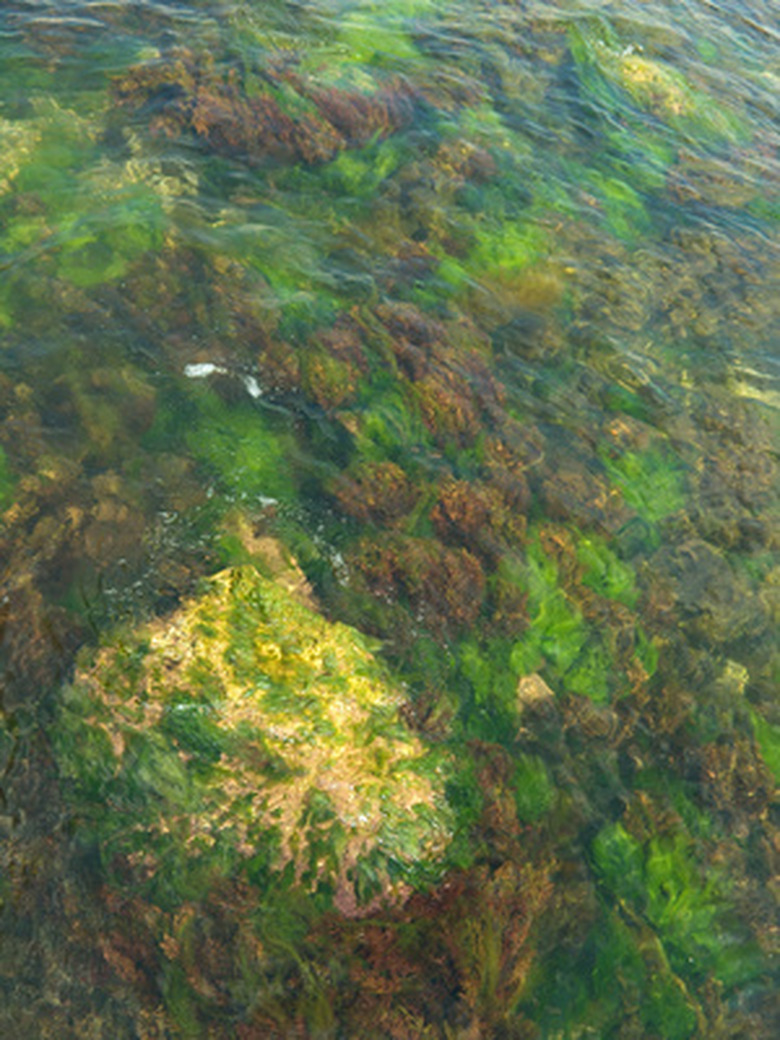Similarities Between Fungi & Algae
Fungi and algae are two common types of complex organisms that are often confused with one another, and both are frequently mistaken for plants. There are many similarities and differences of algae and fungi, as they are two unique types of organisms in two separate kingdoms (kingdom Protista and kingdom Fungi, respectively). Some of the similarities between fungi and algae include their eukaryotic cells, preference for a moist environment and ability to reproduce asexually through the process of fragmentation.
Cellular Similarities and Differences
Cellular Similarities and Differences
Fungi and algae are both eukaryotes, or organisms whose cells contain a nucleus. While plants and animals have diploid cells (cells with two sets of chromosomes), both fungi and algae normally have cells with haploid nuclei – nuclei that contain only one set of chromosomes instead of two.
Because fungi and algae both have complex eukaryotic cells, organisms within these kingdoms can be either multicellular or unicellular. Most types of fungi are multicellular (like all mushrooms, for example), but yeast is an example of a fungus that is unicellular. Examples of unicellular algae are phytoplankton (such as diatoms), and multicellular types of algae include seaweeds (such as giant kelp).
While fungi and algae both have eukaryotic cells, their cells have some major differences. Like plant cells, algal cells and fungal cells have cell walls. The cell walls of algae are made of cellulose, a protein that also occurs in the cell walls of plants. Cell walls of fungi, however, are made up of chitin, which is a protein found in the exoskeletons (hard outer shells) of insects and other arthropods.
Autotrophs vs. Heterotrophs
Autotrophs vs. Heterotrophs
Many species of algae are confused with plants – perhaps because they are green and "leafy" – but these organisms don't have the specialized cells that plants have. Like plants, algae are autotrophs – organisms that produce their own food, usually using the process of photosynthesis. Most algae species contain chlorophyll, the green pigment also found within chloroplasts of plants that is crucial in the process of photosynthesis.
Most algae species need to live in aquatic environments and can live in either salt or fresh water. Some types use different pigments to make their food and can be red, brown, green or blue-green. Algae are responsible for primary production in aquatic food chains and oxygen production for Earth's atmosphere.
Unlike algae, fungi are heterotrophs, or organisms that cannot produce their own food. Most fungi get their food by decomposing other organisms or dead organic matter. Fungi are unique in that they digest their food outside of their bodies by secreting digestive enzymes and absorbing the food once it is digested. Fungi play an important role as decomposers and, while they do need some moisture, can live in diverse environments.
Some types of fungi known as micorrhizae form a relationship with plants. Micorrhizal fungi grow within the roots of plants and provide mineral nutrients to the plant, while the plant will provide carbohydrates for the fungi, which is usually a mutually beneficial relationship.
Asexual Reproduction
Asexual Reproduction
Another similarity between fungi and algae is that they can both reproduce asexually through fragmentation. Fragmentation is a process where the parent organism can break into pieces to grow new individual organisms that are genetically identical to the parent. Most fungi reproduce asexually by producing spores, and most algae will reproduce through cell division, although some species of algae will also use spores to reproduce.
The part of a fungus that you normally see is the mushroom, or the fruiting body of the fungus. This is where spores are produced. Mushrooms are only a part of the fungal body as a whole. Fungi are made up of hyphae - tiny hairlike filaments – that together make up the mycelium (vegetative body of the fungus). Not all species of fungi produce mushrooms; some, like molds, simply release their spores into the air.
A Symbiotic Relationship
A Symbiotic Relationship
One thing that both fungi and algae have in common is their role as _lichen_, which is an organism characterized by a symbiotic relationship including a fungus and an alga (singular of algae). In this relationship, both organisms benefit in ways that they couldn't if they were living separately.
When living together as a lichen, the fungus provides structure, support and shelter for the alga, which in normal circumstances would not be able to live out of water. The alga, in return, provides carbohydrates for the fungus through the process of photosynthesis. There are many kinds of lichen, and they play a very important role in ecosystem function in many different climates.
Cyanobacteria, also known as blue-green algae, are called "algae" because they contain chloroplasts and are photosynthetic. Technically, cyanobacteria are not algae but bacteria – unicellular organisms whose cells lack a nucleus (also known as prokaryotes). Cyanobacteria are sometimes present in lichens and are generally considered to be algae although their cells are drastically different from other species of algae. Some cyanobacteria can produce toxins that can pose a threat to human activities in ocean environments.
Cite This Article
MLA
Reinbold, Joan. "Similarities Between Fungi & Algae" sciencing.com, https://www.sciencing.com/similarities-between-fungi-algae-13427993/. 30 September 2021.
APA
Reinbold, Joan. (2021, September 30). Similarities Between Fungi & Algae. sciencing.com. Retrieved from https://www.sciencing.com/similarities-between-fungi-algae-13427993/
Chicago
Reinbold, Joan. Similarities Between Fungi & Algae last modified August 30, 2022. https://www.sciencing.com/similarities-between-fungi-algae-13427993/
